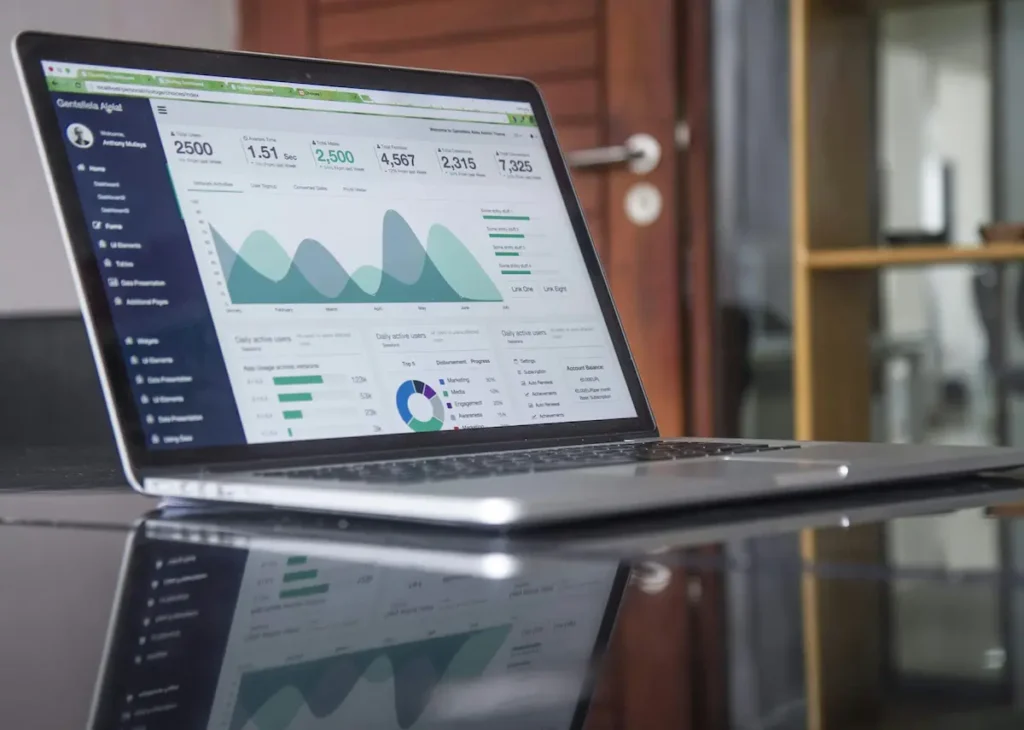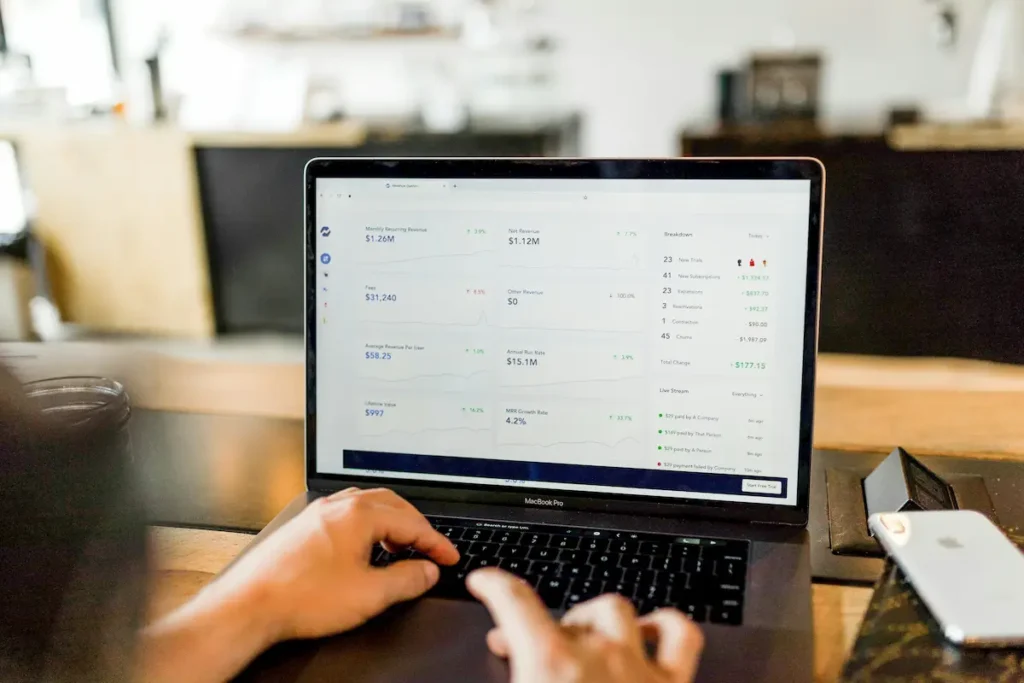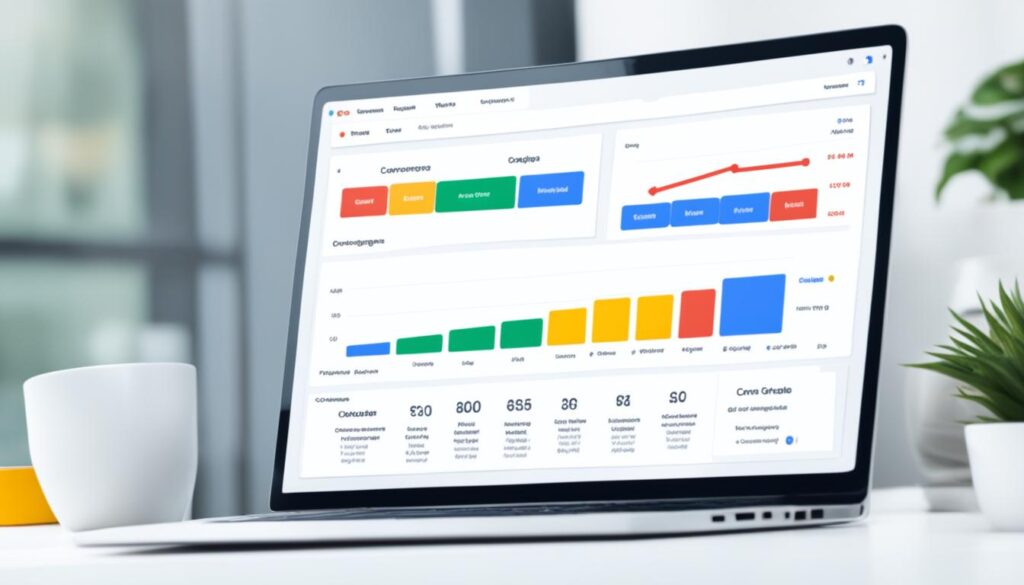Dive into the world of SEM and learn how search engine marketing can boost your online presence and drive targeted traffic to your site.


Did you know, more than 70% of people buy things online with their phones? This big number shows how crucial it is to be visible online now1. Search Engine Marketing (SEM) plays a huge part in your digital marketing plan. It uses paid ads, online ads, and PPC to make sure your business shows up first in search results2. As the internet grows, using SEM to catch the eye of potential customers is key. It’s always changing and getting bigger, but SEM has become a must for any digital marketing scheme.
This guide will cover SEM’s basics, making clear why it’s needed and how it’s different from SEO. Also, I’ll talk about SEM’s platforms, tools, the importance of keywords, and how to tell if your campaigns are working. If you want to grow online and meet new customers, understanding SEM is a must. Let’s see how SEM can lift your business’ visibility, bring in the right people, and make your digital marketing stronger.
SEM stands for Search Engine Marketing. It’s a key tool for companies who want to boost their online visibility. It works through paid ads on search engines like Google and Bing. Unlike SEO’s focus on natural growth, SEM uses paid methods to get quick visibility. By bidding on keywords, businesses can place ads above the normal search results.
It involves bidding on keywords linked to your products. This makes your ads show up as sponsored links on search results. This is very important because more than 70% of buyers use their phones. Also, mobile searches on Google are now more common than on desktops1. So, these ads can bring immediate traffic to your site, offering a great chance for success.
SEM comes with its own set of important terms:
Knowing these terms is crucial for running successful paid ad campaigns. It helps ensure you get more for your money. Using the right SEM tools and strategies is key for those wanting to be leaders in the online world.
Search Engine Marketing (SEM) is vital for companies wishing to increase their online presence. By using SEM, a business can make sure its ads pop up at the SERPs’ top. This catches the eye of people actively looking for what the company offers. Google says that investing in SEM through AdWords can significantly boost a business’s return. This proves how powerful online ads can be3.
SEM boosts a company’s visibility online. It has been shown that search ads can make people 80% more aware of a brand3. Most new site visitors come from search engine queries, underlining the importance of being easy to find on SERPs4. By being at the top of these pages, businesses can be seen by more of their target audience. This increases their chances of connecting with potential customers.
SEM goes beyond being seen. It aims to bring the right people to a website. With SEM campaigns, advertisers only pay when their ad is clicked on. This results in a website visit. It’s a smart way to advertise online4. Getting visitors through SEM often means they’re ready to buy. This gives businesses a chance for more sales. By choosing the right keywords and targeting the correct locations and people, companies can smartly use their SEO efforts. This increases the chance of people not just visiting but also buying from their site.
Additionally, a whopping 75% of people who spot local businesses online visit them in person within a day3. This shows how SEM can directly impact sales. By choosing the right keywords and placing ads smartly, businesses can see a great return on their marketing investment. Their ads are not just efficient but also effective in attracting customers.
SEO and SEM are key in digital marketing. They work differently to get noticed on search engines. SEO boosts your website using natural methods. This means working on your content, structure, and trust with no direct costs.
On the flip side, SEM relies on paid methods. Here, businesses pay to show up for certain keywords. This can bring quick results in visibility.

SEO aims for free, natural traffic by making your site better overall. It does this with great content, links from other sites, and a user-friendly experience. This work helps your site move up Google’s pages over time5.
SEM, however, is all about fast visibility through ads. It uses strategies like PPC and quick paid search campaigns. This way, your site is seen right away when the campaign starts6.
Although both use keywords to attract people, their methods and costs are different. SEO needs a big investment in content and tools upfront. But, SEM requires you to pay for the ads to be seen immediately5.
The time it takes to see results is a key difference between SEO and SEM. SEO is a marathon, not a sprint. It can take months or even years to really see your site’s ranking and business grow6.
Research suggests an average of 2 years to rank on Google’s first page naturally5. On the other hand, SEM can bring instant traffic and sales once your ad goes live5.
This quick boost is great for short-term projects or events. But remember, when your SEM budget runs out, your visibility drops back down6.
Search Engine Marketing (SEM) is vital in digital marketing. It aims to boost online visibility through paid search. By using tools such as Google Ads Manager, businesses can target their audience effectively.
SEM has three key parts: picking the right keywords, making engaging ad copy, and using smart bidding strategies. To start, you need to find the best keywords that your customers use. Then, you create ads that stand out to them. This not only gets you more clicks but also helps you place your ads better1. In the ad auction, businesses compete to show their ads. The result decides who appears first and how much they pay17.
Some think SEM is just about money. But, the Quality Score, based on ad quality and user experience, is crucial. It helps your ads get a better position1. Others expect big, fast results. While SEM can be quicker than SEO, it needs ongoing tweaks to keep working well. A smart SEM strategy can also boost your long-term online presence and credibility7.

Knowing the basics and avoiding these myths helps businesses make the most of online ads. With the right knowledge, you’ll see better results using Google Ads Manager. This can lead to increased interest and sales from the people you want to reach.
In the world of Search Engine Marketing (SEM), three main things matter a lot: keywords, ad copies, and bidding strategies. These pieces are key to making an SEM campaign work well. When used together, they help your ads be seen more and get more clicks.
Keywords are vital for SEM campaigns. They control when and where ads show up, based on what people search for. It is crucial to pick the right keywords carefully. You should think about broad match, phrase match, and exact match keywords. Also, don’t forget about negative keywords, which stop ads from showing to the wrong people. Choosing the right keywords is important because almost half of shoppers look for new products on Google1.
Ad copies are what users see and read in your ads. Making them interesting and easily understood is critical to get people to click. At Zeralabs, they saw better ad positions and lower costs by making their ads more relevant to their keywords1. Adding ad extensions can also help. They give more info and make people more likely to click8.

Bidding right can make your ads cost less and show up more. In SEM, you bid on keywords that show a clear interest in what you offer. You also need to consider Quality Score, which Google uses to measure how good your ads are1. Focusing on long-tail keywords, which are longer and more specific, can give you better results8. Dominik Mąka’s advice is to start with less competitive, long-tail keywords to get more from your budget1.
Doing good research on keywords, writing compelling ad copies, and smart bidding are crucial for SEM success. Menus, either Google AdWords or Meta ads, can help you reach your ad goals effectively.
Keywords are the heart of a successful SEM campaign. They link search questions to ads. This is critical for ads to be spot on. Businesses that know how to use different keyword types well get the best results from their ads.
In SEM, we group keywords by how they match: broad match, phrase match, exact match, and negative keywords. Broad match keywords cast a wide net but may not be very on-point. Phrase match targets queries with a certain phrase, balancing reach and relevance. Exact match is for precise, specific searches, keeping content highly relevant. And negative keywords play a key role in saying no to non-relevant searches. This can save money and make campaigns more effective.

Good keyword research is key for any SEM success. It means finding words that connect with your audience and meet your goals. Tools like Google Adwords Keyword Planner and SEMRush are great for this task. They help evaluate search trends, competition, and costs. This information is crucial for adjusting your paid search strategy to meet your goals and boost conversions9.10
Not forgetting negative keywords is crucial too. They stop your ads from showing in searches that don’t fit. This prevents wasting money and makes your campaign more efficient10. By focusing your budget on more relevant searches, you can up your chances for conversions9.
Regular keyword research and careful keyword management are key. They lead to better results in PPC advertising. This strategy can help you see a good return on investment from your paid search activities.
In digital marketing, knowing SEM platforms well is key for good online ads. Google Ads, Bing Ads, and Meta Ads are three top platforms. They each have unique ways to reach and engage with your audience11.
Google Ads is great for ads that match what people search for online. It helps businesses big and small reach their specific audience. With its tools like Keyword Planner and Google Trends, you can find the best keywords and plan your budget. This can make your ads work even better11.
Quality Score is important in Google Ads. It shows how well your ads match what people want to see. Ads with a high Quality Score can cost less to show to people.

Bing Ads is another good option for ads, often cheaper than Google. It lets you target your ads just like Google Ads does. This means you can show the right ad to the right user at the right time. Using Bing Ads can help you find new customers online12.
Meta Ads mean you can advertise on Facebook and Instagram. This is great for reaching millions online. You can target your ads very precisely. It helps you talk to people who are most likely interested in what you offer1.
Using Meta Ads, your business can connect with people in a personal way. This boosts your brand on social media.
Here’s a table that compares key features of the SEM platforms:
| Platform | Unique Features | Cost-Per-Click (CPC) | Targeting Options |
|---|---|---|---|
| Google Ads | Extensive reach, Quality Score, Keyword Planner | Higher but variable depending on quality score | Demographic, Behavioural, Geographic |
| Bing Ads | Lower CPC, unique audience, similar targeting as Google | Generally cheaper than Google | Location, Device, Time of Day |
| Meta Ads | Social media integration, Carousel & Dynamic Ads | Varies based on ad engagement | Interests, Behaviours, Demographics |
Starting a powerful SEM campaign involves taking some key steps. It’s vital to grasp each step to make sure the campaign meets its targets and shows results. Let’s break down these crucial points.
The first thing to do in an SEM campaign is to set goals. These goals can be about getting more leads and boosting sales or making your brand more well-known. With about 80% of people looking up products online first, having clear goals is key to your SEM success13. This clarity helps focus all your efforts, including where you place your ads and what they say, on reaching these outcomes.
Handling your budget well is crucial in SEM success. Businesses can spend a lot on SEM each month13. Smaller to medium-sized companies, for example, might put in $9,000 to $10,000 a month13. It’s vital to set a budget that lines up with your marketing plans. This budget can vary depending on how competitive your keywords are and how wide you want your reach to be. Good budgeting means using your resources smartly to keep making money.
Good ads are at the heart of a winning SEM campaign. You need to make ads that grab attention, tell your story well, and get people to act. Studies show that those who click on ads are half as likely to buy13. This proves that making your ad content strong can boost how many people actually buy from you and bring in the right visitors.
| Component | Description |
|---|---|
| Goals | Clear objective setting such as lead generation, sales, or brand awareness. |
| Budget | Allocating a daily or monthly budget that aligns with your marketing goals. |
| Ad Creation | Crafting eye-catching headlines, engaging descriptions, and compelling CTAs. |
To sum up, successfully managing an SEM campaign is all about how you set your goals, handle your money, and make your ads. By following these steps, you can ensure that your campaigns efficiently reach the right people, are cost-effective, and bring the results you’re aiming for in sales and overall performance.
Knowing how to measure the impact of SEM campaigns is key. This helps in getting the most out of your money and improving your plans. You can learn a lot from metrics like CTR, conversion rate, CPC, and Quality Score. These metrics show how well your campaign is doing. Quality Score is especially important. It ranges from 1 to 10. A better score means your ads can be cheaper and show up more prominently1.
An SEM campaign’s success relies on several vital metrics. CTR measures how many people click on your ad when they see it. This directly shows how interested people are. Conversion rate is crucial too. It tells you how many visitors actually buy something or fill out a form. CPC can swing from $2 to $55 based on your market. It’s vital to control these costs well11. Quality Score plays a major role in these metrics as well1.
Keeping track and reporting your SEM campaigns is a must. Tools like Google Ads Manager, SEMrush, or HubSpot offer data in real-time. This data can help you make instant changes to your ads based on your audience’s needs14. Reports should cover ad spend, conversions, and revenue from paid ads. Analyzing these helps you fine-tune your campaign. This ensures your ads speak to your audience and turn clicks into sales11.
By carefully watching these metrics and adjusting your campaigns, you can use SEM to stand out online. With continuous improvement and regular checks on your results, you can reach your digital marketing goals. This approach guarantees a strong return from your SEM investment over time.
Search Engine Marketing (SEM) is how you get seen on Google and Bing. It pays to be at the top. Ads on these search engines are the main trick.
In SEM, you’ll hear about PPC, Google AdWords, CTR, and Quality Score. These help us understand and manage online ads. They show us how well our ads are doing.
SEM puts your business right where people are looking. Being up there means more clicks. This can lead to more sales and visitors to your site.
SEM pinpoints people who are likely to buy what you offer. By choosing the right keywords and settings, your site can attract more potential customers. This means more sales for you.
SEO and SEM both try to get top spots online. But, SEO gets there without paying. SEM ads get you there fast but for a cost. They use different ways to get you noticed online.
SEM works by picking the right words, making great ads, and smart bidding. It’s all about showing the right ad to the right person. By always checking and adjusting, your ads can do better.
Some think SEM is only about paying for ads. It’s more, like using the best keywords and having good ads. Another myth is that it brings instant and long-term success. Actually, it needs constant work to stay at the top.
Keywords are like the map to your ads. The right ones lead the right people to your site. By choosing wisely, you can find your target customers easily.
In SEM, you can use broad, exact, and phrase match keywords. Each kind helps in a different way. Make sure to also use negative keywords to avoid the wrong kind of visitors.
Researching keywords is where your SEM journey begins. It’s vital to pick terms that really meet people’s needs. By understanding which words are best, you can stand out online.
Negative keywords stop your ads from showing in searches that don’t fit. They help save money by not showing your ads to people who won’t buy. This makes your SEM more cost-effective.
Google Ads, Bing Ads, and Meta Ads (like Facebook) are the big players. Each has its own strengths for getting your message out. Together, they cover a wide online area.
Google Ads let you put your message in front of millions. You pick keywords, set a budget, and Google does the rest. It’s a smart way to be noticed online.
Bing Ads are another way to advertise online. Since not everyone uses Google, Bing reaches those not found there. It’s a way to expand your online reach.
Meta Ads let you advertise on Facebook and Instagram. They offer unique ad styles, perfect for engaging users. This makes it easy to connect with people online.
Goals give your SEM campaign direction. They help plan the steps to take. With clear goals, you can measure how well your ads work for you.
Managing your budget well is key in SEM. It sets the size and life of your campaign. A good budget plan lets you get the most out of your ads.
When making ads, make them stand out. Good headlines, descriptions, and CTAs are a must. Also, choose formats that your audience will like. This leads to more clicks and sales.
To see if your ads work, check CTR, conversion rates, and CPC. These numbers tell you how well your ads and keywords are doing. They help you make things better.
Tracking your ads and seeing reports is like using a map. It shows you where to go to do better. This data helps fine-tune your strategy for a better online outcome.
